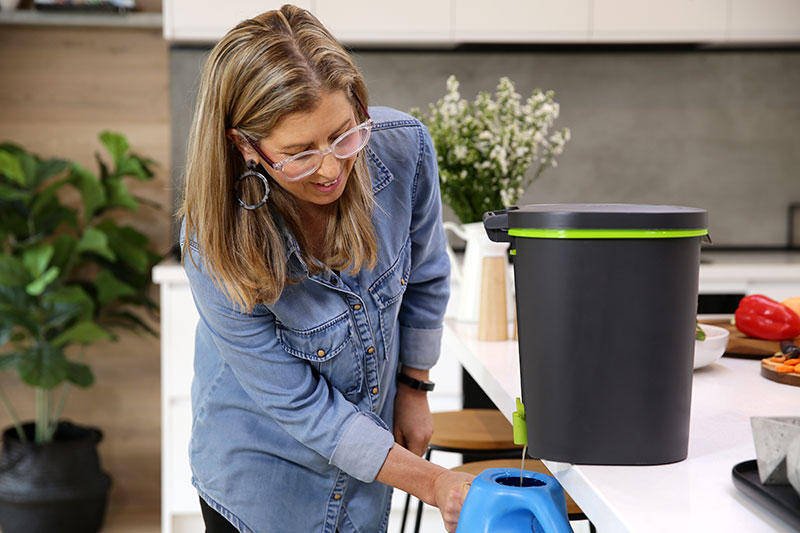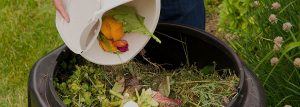Indoor composting using Bokashi is a great way to create valuable nutrient-rich plant food using organic food waste from your kitchen year-round. The anaerobic process of Bokashi utilizes inoculated bran to effectively ferment everything such as fruits, vegetables, meats, and dairy.
Using a Bokashi Bin for Indoor Kitchen Composting
An easy-to-use Bokashi bin lets you recycle organic kitchen waste with no smells or unsightly flies. It acts as the first waste collection point. You can then take the organic formula and add it to a larger outdoor compost bin, worm farm, or directly into your garden so your plants start reaping the nutritious benefits. With an indoor composting system, you recycle all your kitchen organic waste in an air-tight container. You rely on Bokashi to act as the compost activator.
What is ‘Bokashi’?
Bokashi is Japanese for ‘fermented organic matter’. It is a bran-based compound (although some are formulated from wheat mill run, rice, mushroom growth, sawdust, or dried leaves) that must undergo inoculation and fermentation with friendly and beneficial bacteria EM. The formula is then dried for storage. You can also find it as a liquid spray. The purpose of Bokashi is to aid in the organic fermentation process.
How to Kitchen Compost with Bokashi
Place your waste food products in a kitchen compost bin and lightly coat the waste with a handful of Bokashi. If you are using liquid Bokashi then squirt two to three squirts into the kitchen composter. Press the Bokashi into the food waste using the trowel that is included when you purchase the kitchen composter. and then sprinkle a little more over the food. Close the lid.
If you are trying to compost large pieces of food or bones, then you should chop them into smaller chunks for greater efficiency. Cutting the items into smaller pieces reduces the length of time needed to compost.
When the kitchen compost bin is full then you remove the nutrient rich formula and move it outdoors to an outside compost bin, worm farm, or for later use in the garden. Remember, it typically takes ten to fourteen days for food to fully compost. You can use the handy spigot on the side of the kitchen composter to drain off the organic tea formula.
Maintenance of the Kitchen Compost
Remember, the process of Bokashi is anaerobic so you’ll want to keep it relatively free of oxygen so the waste should always be compressed in the container daily to remove all air pockets and keep from stirring up the previous days food additives. You can use a plate to press the composting food flat if you do not have access to the trowel and remove the air pockets. Then replace the lid. Also, drawing off the liquid maintains the environment needed for the bacteria to effectively perform the breakdown. After drawing off the liquid, you must use the mixture within a day or two.
Does the Fermentation Process of Indoor Composting Smell?
Some people stay away from indoor composting because they are worried about unpleasant smells permeating the home. The good news is, that when done properly, Bokashi fermentation process produces no smell.
You can keep the indoor compost bucket under the sink, in a cabinet, closet, or anywhere else within your home’s kitchen so you can enjoy smell-free 100 per cent organic waste recycling. The key with the Bokashi is that it is only made up of friendly, safe bacteria so you effectively bypass stink.
Benefits of a Kitchen Composter
Kitchen composting is a convenient way to start recycling organic food indoor. Unlike outdoor compost bins, indoor bins can be used daily without having to go outside to dispose of kitchen waste. This is particularly convenient in cold or wet weather and is a good solution for elderly people looking to avoid frequent trips to the garden to dispose on kitchen waste.
Other common benefits include:
- Kitchen compost helps to decontaminate the soil by reducing the potential pollutants and pathogens
- Encourages beneficial fungi growth.
- Eliminates the need for potentially harmful chemical fertilizers in the garden.
- Versatility because you can bury the fermented waste in directly in the garden soil or use it in an outdoor compost bin.
- Reduces greenhouse emissions and harmful methane production at landfills.
- 100% organic waste recycling. Cooked and uncooked food including meat, fish, dairy products, fruit and vegetables may be safely composted indoor.
- Small & compact for the kitchen.
- No smells because friendly safe bacteria are used.
- Avoids trips to an outdoor composter after every meal. Ideal in winter or for the elderly or enfeebled.
- Will rebuild the soil in your garden and will decontaminate soil from harmful pathogens and pollutants.
Troubleshooting the Kitchen Compost Bin
- Unpleasant smell: If your Bokashi bin smells, then something has gone wrong. A functioning kitchen composter should have a sweet and sour odor (think yogurt-like) but if the smell turns nasty then there is a problem. Please remember, Bokashi never smells like other decay because the microbes in the kitchen composter do not produce sulfur acid as outdoor compost piles do. If your kitchen compost starts to decay, then you will need to promptly try to reverse the process by adding more Bokashi. If you still cannot get rid of the smell then it’s time to dump the decaying compost, wash the composter and start over.
- Mold: The appearance of green mold in the compost also indicates something has gone wrong. White mold is normal, but green means the entire process of fermentation is failing.
About Maze Indoor Bokashi Compost Bins
Maze kitchen compost bins comes in different sizes, ranging from small 7lt bins to larger 18lt bins. Some of the larger bins, includes a draining tap that can be used to drain the liquid produced as part of the organic matter breaking.
You can view our range of kitchen composters and accessories here.




